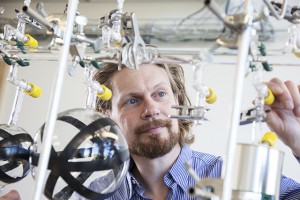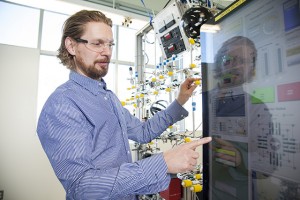International Research Collaboration Finds Replacement for Industrial Gas, SF6, Lowers Industry’s Climate Impact by More Than 90 Percent
As scientists across the globe explore the atmospheric impacts of greenhouse gases such as methane and carbon dioxide California State University, Northridge atmospheric chemist Mads Sulbaek Andersen looks to find a replacement for an unassuming yet ubiquitous source of global warming — a fluorinated sulfur compound known as SF6.
An international research collaboration between lead-author Sulbaek Andersen and co-authors at Copenhagen Center for Atmospheric Research (CCAR) and University of Oslo shows that a new replacement compound could reduce the carbon footprint of SF6 usage by at around 93 percent. Their study has just been published in the journal Environmental Science and Technology.
SF6 is used in high-voltage circuit breakers and transformer stations across the world as a nonconductive gas. Although it is nontoxic, on a molecular level its impact on the environment is significant.

CSUN atmospheric chemist Mads Sulbaek Andersen measures the Global Warming Potential of compounds that may go into the atmosphere using custom lab equipment. Photo by Lee Choo.
Sulbaek Andersen explained the high impact SF6 has on the environment.
“More than 10 tons of SF6 is produced every year, and emissions are currently between 5.7 to 7.4 tons a year. Fractionally, that is quite a bit,” he said. “And that becomes an issue when we are dealing with such an extremely long-lived greenhouse gas as SF6. When SF6 is released to the atmosphere it stays around for thousands of years.”
The proposed replacement compound 2,3,3,3-tetrafluoro-2-(trifluoromethyl)- 2-propanenitrile was studied for its atmospheric lifetime and global warming potential (GWP). GWP is used to measure the integrated climate effect of one kilogram of a substance compared to one kilogram of carbon dioxide.
The lifetime of a compound is measured by how long it takes for it to break down into and disappear from the atmosphere. Its ability to absorb thermal radiation also is a major factor of a compound’s GWP. SF6 has a lifetime of 3,200 years and a GWP integrated over 100 years of nearly 24,000 times that of carbon dioxide, making it the most potent greenhouse house gas known to man.
The new compound’s lifetime is 22 years and its GWP 1,500.

CSUN atmospheric chemist Mads Sulbaek Andersen observes the Global Warming Potential of certain compounds utilizing custom made equipment. Photo by Lee Choo.
“The magnitude of the difference compared to SF6 is pretty astounding,” collaborator Ole John Nielsen said. “Twenty-two years is still a very long lifetime. But because it is so much shorter than that of SF6, the GWP is much lower. If we assume an emission rate similar to that estimated for SF6 and replace it 1 to 1 with this stuff, then one can reduce the impact on climate to what corresponds to 93 percent down from SF6. That’s a big impact.”
Sulbaek Andersen said the industrial implications for the new compound are major, and give hope for the process of continued environmental improvements for the future.
“If you want to be effective in addressing the issues [environmental change] relating climate and greenhouse gas emissions, you have to do it systematically and on a sector-by-sector basis,” he said. “Emission of CO2 is the main driver of climate change, and for the electricity industry, direct emission of CO2 is the primary concern, but down the distribution grid, this will be huge. We used to think high-voltage switch gears would be impossible without something like SF6. Now there may be a solution.”

 experience
experience